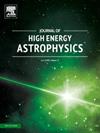Influence of minimal gravitational decoupling and pseudo isothermal dark matter halo on mass-radius relation and stability of anisotropic compact stars in f(R,T)–gravity
IF 10.2
4区 物理与天体物理
Q1 ASTRONOMY & ASTROPHYSICS
引用次数: 0
Abstract
We have provided a new exact solution for anisotropic compact stars to the field equations of -gravity via a decoupling technique, with the assumption of a linear function and the modified Durgapal-Fuloria metric ansatz. By deforming the radial component of the metric and introducing Pseudo-Isothermal (PI) dark matter (DM) as a new source to the anisotropic seed solution in the process of minimally gravitational decoupling, we have obtained a non-singular solution that meets all physical criteria related to effective density, effective pressure, effective anisotropy, and energy conditions. The present system satisfies the modified Tolman-Oppenheimer-Volkoff equation and achieves stable equilibrium, fulfilling stability criteria such as the adiabatic condition, Herrera cracking concept, and Harrison-Zeldovich-Novikov condition. The influence of minimally gravitational decoupling on the characteristics of the system has been illustrated graphically by varying the decoupling constant (γ). The mass-radius relations are linked to observational constraints and examined for anisotropic stellar systems with and without the effect of minimally gravitational decoupling in both general relativity (GR) and -gravity. We found that increasing values of the -gravity parameter (χ) and γ reduce the maximum allowable mass of the star. Therefore, increasing the effects of minimally gravitational decoupling and the PI-DM content, subject to the Durgapal-Fuloria metric potential ansatz, cannot support highly compact and supermassive astrophysical objects.
最小引力脱钩和伪等温暗物质晕对各向异性紧凑星在 f(R,T) 引力下的质量半径关系和稳定性的影响
我们通过解耦技术为各向异性紧凑恒星的f(R,T)引力场方程提供了一个新的精确解,并假定了线性f(T)函数和修正的杜尔加帕尔-富勒里亚公设解析式。通过对度量的径向分量进行变形,并在最小引力解耦过程中引入伪等温(PI)暗物质(DM)作为各向异性种子解的新来源,我们得到了一个非星状解,它满足与有效密度、有效压力、有效各向异性和能量条件相关的所有物理标准。本系统满足修正的 Tolman-Oppenheimer-Volkoff 方程并达到稳定平衡,符合绝热条件、Herrera 裂缝概念和 Harrison-Zeldovich-Novikov 条件等稳定性标准。通过改变解耦常数 (γ),以图表说明了微引力解耦对系统特性的影响。质量-半径关系与观测约束相联系,并对各向异性恒星系统在广义相对论(GR)和 f(R,T)引力下有和没有微引力解耦的影响进行了检验。我们发现,f(R,T)引力参数(χ)和γ值的增加会降低恒星的最大容许质量。因此,在杜尔加帕尔-富洛里亚公势解析条件下,增加最小引力解耦效应和 PI-DM 含量无法支持高度紧凑和超大质量的天体。
本文章由计算机程序翻译,如有差异,请以英文原文为准。
求助全文
约1分钟内获得全文
求助全文
来源期刊

Journal of High Energy Astrophysics
Earth and Planetary Sciences-Space and Planetary Science
CiteScore
9.70
自引率
5.30%
发文量
38
审稿时长
65 days
期刊介绍:
The journal welcomes manuscripts on theoretical models, simulations, and observations of highly energetic astrophysical objects both in our Galaxy and beyond. Among those, black holes at all scales, neutron stars, pulsars and their nebula, binaries, novae and supernovae, their remnants, active galaxies, and clusters are just a few examples. The journal will consider research across the whole electromagnetic spectrum, as well as research using various messengers, such as gravitational waves or neutrinos. Effects of high-energy phenomena on cosmology and star-formation, results from dedicated surveys expanding the knowledge of extreme environments, and astrophysical implications of dark matter are also welcomed topics.
 求助内容:
求助内容: 应助结果提醒方式:
应助结果提醒方式:


